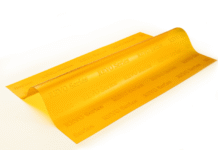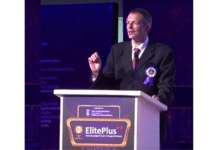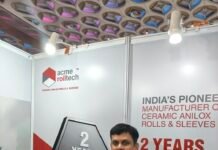
On 28 July 2020, we took part in a webinar organized by four companies working together on an exciting technology for recyclable flexible packaging that could be safer, healthier, and cost-effective enough to make it a reality. These four are respectively, suppliers of blown film lines, CI flexo presses, inks, and electron beam curing systems.
The explanation of the new recyclable packaging concept began with Mohamed Timol of Reifenhauser, who spoke about new recyclable PE and paper structures. Jordi Puig from Comexi spoke about the special Gelflex technology eBeam curing CI flexo press, which also works for conventional and water-based inks. Evan Benbow of WikoffColor explained what the gel-based eBeam curable inks and coatings are and how they work. He described the attributes and properties that make them bright, scuff-resistant, and easy to de-ink for lateral recycling printed packaging. Lastly, Imtiaz Rangwalla of Energy Sciences explained the entire process and its benefits and the ebeam curing technology.

The almost two-hour webinar put forward the prospect of creating new film and paper structures with minimal amounts of aluminum or EVOH that meet recycling standards. The webinar then proposed that these be printed and even coated in a specially developed Comexi CI flexo press using Gelflex ebeam curable inks provided by the ink manufacturer WikoffColor in a 7-color extended gamut process. The press and process would also allow an overprint varnish (OPV) to be applied in the last unit and then cured using the single unit end of press ESI eBeam curing system.
All the hardware and consumables change in this new process, although ebeam curing has been used for a long time for curing flexible packaging even in India. In India, it was used on a CI flexo printing press to produce flexible packaging for pet foods. The idea of using eBeam curing was to reduce one layer in the laminate and protect the surface with a coating that would not leave solvent traces.
During the webinar, Jordi Puig of Comexi said that the newly designed press is capable of printing using three types of inks — solvent-based, water-based, and Gelflex. This will allow printers who invest in the new technology to continue to print on flexible laminates as they are doing now. They can then perform the trials and learning needed to migrate first to water-based and ultimately to the Gelflex-based eBeam curable method.
How does Gelflex-EB curing flexible packaging printing work?
I am taking the liberty to quote liberally from the Energy Sciences explanation of how flexible packaging printing works using Gelflex-EB cured inks and coatings. Unlike traditional inks, with Gelflex-EB, a fully formed polymer is not required. Gelflex-EB technology includes microscopic polymer chains that reduce resistance to flow. Using virtually no solvents, the gel-based technology allows ink to adhere almost instantly to a substrate by way of a covalent bond, resulting in no color bleed.
In its reaction with an e-beam, Gelflex-EB crystallizes and cross-links polymer chains to create a contiguous and homogenous layer of polymerized print. The two-part gel and solvent EB inks have superior physical properties and dot gain, are fluid enough for flexo printing, and thicken rapidly, providing effective ink trapping in the wet state as the solvent evaporates and a gel is formed. Only one EB dryer is required per press, eliminating all inter-station and end-of-press thermal dryers.
The webinar put forward the idea of using six or 7-color extended gamut printing (ECG), a solid white in the first unit (if needed), an overprint varnish in the last print unit, and using just one eBeam dryer to achieve significant cost savings. Starting with the use of a single polymer structure stretched to enhance its mechanical properties and using ECG printing and an OPV with eBeam curing, more easily recyclable packaging can be economically produced. The lower energy costs of eBeam curing are also an overall factor.
Electron beam basics
An electron beam processor is a device that accelerates electrons to high energies and projects them into a substrate. Filaments under vacuum emit electrons, and a high-voltage gap accelerates the free electrons. High-energy electrons pass through the window foil and strike the substrate and cause the desired molecular changes in the product.
It was stated in the webinar that because Gelflex-EB Inks contain no photoinitiators, they are completely safe for food packaging. Examples were shown of Nestle and Pepsi packaging that meets Swiss standards for migration and is FDA compliant. EB is one of the most environmentally clean processes, with most inks and coatings containing no VOCs.
This new method takes sustainability as a strict necessity and opportunity. The solution presented involves new approaches to the substrates, inks, coatings, and flexo printing and curing. It is not child’s play to understand all these components, invest in them, and migrate from conventional flexo and gravure to this unique, and dare I say exciting process. However, when the future requires desirable outcomes in the first place rather than the mere mitigation of deficient materials and methods, it becomes necessary for flexible packaging printers to look at this new process.
Question & Answers
There were questions and answers that showed interest from many regions including Africa and Asia. I also asked a question that was answered by Jordi Puig a couple of days later by email.
Question: Does the EB curing unit require some kind of gas say in a nitrogen box or some other gas?
Jordi Puig answered: Electron beam cured inks and OPV cure by the free radical mechanism. These reactions are oxygen inhibited. To achieve an acceptable cure the process zone needs to have Oxygen concentration less than 150 ppm. This is achieved by a continuous flow of nitrogen gas. Also, electrons like in corona treatment create ozone. To minimize ozone generation and meet with OSHA guidelines the process zone needs to be flushed with nitrogen.
If you require more information please do not hesitate to contact me or my colleagues at ESI who are here in cc.












Thank you Naresh. It was a pleasure to have you here!
GelFlex is truly an exciting technology for our times.
Ed Maguire
President/COO
Energy Sciences Inc.